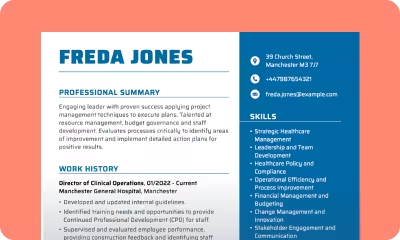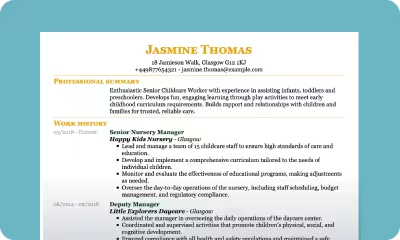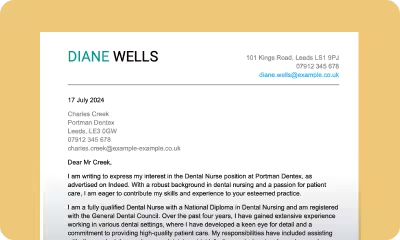- Our customers have been hired by : *Foot Note
An academic cover letter is more than just a formal introduction – it’s your chance to showcase your research interests, teaching philosophy, and qualifications as a scholar. Whether you’re applying for a faculty position, postdoc, or fellowship, a well-written cover letter can help you attract the hiring committee’s attention in a competitive academic landscape.
Our cover letter examples, templates, and writing tips will help you demonstrate your potential. Thanks to our cover letter builder, you’ll be able to craft a compelling document tailored to the specific role you’re seeking.
Academic Cover Letter Sample
Colleen James
217C Fairey Street
Birmingham B45 8GWA
07912 345 678
colleen.james@example.com
9 October 2024
John Smith
University of New Technologies
Manchester, M60 3TT
hr@ntuniversity.co.uk
Dear Mr Smith,
I am writing to express my interest in the Senior Lecturer position at the University of New Technologies. With a strong commitment to helping students grasp the complexities of new technologies and a comprehensive background in artificial intelligence and media, I am excited about the opportunity to contribute to your institution.
I am a self-motivated and progress-driven media specialist with a proven track record in implementing innovative teaching strategies that enhance student engagement and learning. Throughout my career, I have consistently demonstrated initiative in both academic and media roles, focusing on delivering results that align with organisational and university goals.
In my current role as a senior lecturer specialising in artificial intelligence in media, I deliver engaging lectures and seminars at both undergraduate and postgraduate levels. I develop innovative curricula and supervise student work, ensuring practical application of theoretical knowledge. My responsibilities also include assessing assignments, publishing my findings, and matching students with industry partners for internships and collaborative projects.
I have enclosed my CV for your review. I would appreciate the opportunity to speak to you regarding my candidacy for the Senior Lecturer role, and am available for a call or interview at your convenience.
Yours sincerely,
Colleen James
How to Write an Academic Cover Letter
As an academic, knowing how to craft a strong cover letter is essential. This element of your job application allows you to demonstrate both your professional and academic accomplishments, as well as your notable research contributions and teaching experience. Overall, it’s the perfect opportunity to make a lasting first impression while showcasing how your background aligns with the specific requirements of the position.
Learn how to write an impactful academic cover letter with our step-by-step guide and practical advice tailored to the academic job market.

Here’s a step-by-step guide to writing your academic cover letter:
Step 1: Review academic job duties and responsibilities
As you’re preparing for crafting your letter, spend a few minutes analysing the job description. Pay attention to the specific requirements that the employer specified in the job ad. Depending on what duties and responsibilities they mentioned, you may determine if they’re more likely to prioritise candidates with extensive teaching background or those who can utilise their professional experience to guide and support students.
Focus on the specific skills that the ideal candidate for the role should have. For most academic roles, this includes skills such as curriculum development, knowledge of teaching methodologies, or lecture planning. It’s also beneficial to have at least some experience with marking and presentation software.
Step 2: Include contact information and date
At the top of the academic cover letter, write your contact details. This includes your name, address, phone number, and email address. Make sure this information matches your CV’s contact section. In a new line, include today’s date.
Next, follow with the employer’s contact information. If you know the name of the hiring manager, use it to address your letter. Addressing them directly is a nice personal touch, which demonstrates your genuine interest in the position and shows that you’ve made an effort to research the institution before completing your application.
If you’re unsure who’s responsible for processing applications, you can address the institution’s hiring committee or hiring team.
Here’s an example of a well-structured contact section:
Edward Wallace
5 Kendell Street
Sheffield S1 5EH
+07912 345 678
edward.wallace@example.com
9 October 2024
Jenna Smith
Greenfield University
Sheffield S1 1AA
hr@greenfielduni.ac.uk
Step 3: Choose the right professional greeting for an academic setting
To start your cover letter, choose a professional greeting. You typically want this element of your letter to match the employer’s contact information. You can often find it in the job posting, on the company website, or through professional networking sites, like LinkedIn.
If you’re unsure of the recipient’s preferred pronouns, avoid using honorifics, such as “Mr” or “Ms”. Instead, use their full name. Whenever possible, avoid using the generic phrase ‘To Whom It May Concern’, as many hiring managers consider it outdated.
Dear Ms Smith,
OR
Dear Hiring Team,
Step 4: Write a strong introduction for your academic application
Use the first paragraph of your cover letter to introduce yourself and show your interest in the position. This is the right place to briefly highlight your academic background and use catchphrases to spike the reader’s interest. For example, you can mention your experience with adult education, academic expertise, or your curriculum development abilities.
These phrases serve as keywords within your academic cover letter, making sure not only readers but also applicant tracking systems, see you as an experienced academic and suitable candidate for the position. Some good keywords you may use for your academic cover letter and the rest of your application include “research expertise”, “student engagement”, “inclusive teaching”, or “assessment strategies”.
In my search for new professional endeavours, I was thrilled to find the Lecturer opening with Greenfield University. As an ambitious academic with over three years of adult education experience, I believe that I’d make an excellent addition to your team.
OR
I am writing to express my interest in the lecturer position at Greenfield University. With a strong background in adult education and a commitment to creating dynamic, inclusive learning environments, I am eager to contribute my skills and academic expertise to your institution.
Step 5: Discuss your experience as an academic
In the body of your cover letter for academic position, talk about your experience and academic credentials. Depending on the role’s requirements, you may discuss aspects like your research interests or teaching philosophy. If you’ve formerly worked in an academic setting, mention how your contributions helped the department achieve its internal and institutional goals.
As this is likely to become the longest section of your cover letter, use it to assure the hiring committee that not only your experience but also your personality matches the institution’s mission and values. For example, through discussing your commitment to foresting inclusive and diverse student communities and emphasising the importance of innovative approaches to teaching.
In my previous role as an Assistant Professor at Bridgemont University, I developed and delivered lectures and seminars. My responsibilities also included assisting the head of the media department with conducting research and designing quantitative research methods. I provided academic advising to students and contributed to curriculum development. As part of my duties, I regularly participated in departmental and university committees, as well as industry events and conferences, during which I helped senior professors prepare lectures, deliver speeches, and present their findings.
OR
In my previous role as an Assistant Professor, I developed a strong research portfolio in marketing and communications. I contributed to five peer-reviewed publications, which allowed me to secure external funding for the university’s ongoing projects. During my time at Cornell University, I implemented innovative teaching strategies and helped students adapt to a hybrid teaching model by helping them adapt to diverse learning settings. My commitment and dedication led to the increase in student engagement and improved course evaluations, as seen in the university’s annual quality review.
Step 6: Explain why you’re perfect for the academic position
In a new paragraph, explain how your experience aligns with the specific requirements of the position. This shows the hiring committee that you’re determined to apply your skills and expertise to help their institution succeed. As you’re describing your perfect fit for the position, you can reference any recent news or updates that your prospective employer shared on their website or blog. For example, if they’ve announced upcoming research projects, highlight how your unique contributions may support those initiatives.
My extensive experience in cognitive psychology and the latest findings align well with the university’s upcoming research initiatives. Over the past few years, I’ve published several articles on how technology impacts children’s cognitive development, and I’d love to contribute to enhancing the department’s course offering. I believe that my expertise in this field can significantly improve Cornell students’ understanding of early-stage cognitive development.
OR
I believe that my experience and accomplishments in environmental science align with your department’s focus on climate change solutions. I’m particularly impressed by your approach to educating students on the innovative and non-invasive ways of coral reef preservation. Thanks to my experience and extensive network within the field, I am well-positioned to facilitate partnerships and internships that provide students with hands-on experience and the opportunity to work with organisations dedicated to climate action.
Step 7: Close your academic cover letter
In the last paragraph of your cover letter, thank the hiring team for their consideration and restate your interest in the position. You can mention your attached CV and, if applicable, research portfolio. Keep this closing section short and to the point, as it primarily serves as a conclusion.
Close the letter with a professional salutation. For academic positions, it’s best to use more formal sign-offs, like “Yours sincerely”, “Kind regards”, or “Thank you for your consideration”.
Step 8: Proofread and edit your cover letter for academic position
Proofreading is a key element of crafting a job application, as it allows you to make sure the information you submit in your CV and cover letter is up-to-date and aligns with the employer’s expectations and requirements. During this step, be sure to check if the contact details of your cover letter match those on your CV.
Proofread the letter carefully to avoid any grammatical or spelling mistakes. Pay attention to how you present the letter, including what font you use. The best font for cover letter may vary depending on how much experience in the academic field you have. For example, if you’re applying for your first job in academia and want your academic cover letter to appear fuller, consider fonts with rounded edges and spacious lettering, like Calibri.
It’s also important to perfect the visual elements of your letter, including the margins and section spacing, which make your cover letter look clean and professional.
Your Academic CV
Using a well-designed academic CV template can enhance your application and increase your chances of securing a job interview. Reviewing strong CV examples is also a great way to find inspiration for advancing within the world of academia. Our tool makes CV building easier – allowing you to focus on the best way of presenting your expertise to the hiring team!
Common Questions About an Academic Cover Letter
How long should an academic cover letter be?
Understanding how long a cover letter should be is a key element of structuring your job application correctly. Ideally, you want your academic cover letter to be one to two pages in length. As you’re writing the letter, make sure you provide a compelling introduction to your qualifications, both in academia and the industry in which you specialise, like science or literature. At the same time, try making the letter concise. Double-check to make sure the document doesn’t include information that you’ve included in your CV.
Is there a difference between a standard and an academic cover letter?
There are several differences between a standard cover letter and a cover letter for academics. Academic cover letter examples usually include not only information about someone’s skills and experience but also their research accomplishments and teaching philosophy. These letters also adopt a more formal tone.
How can I tailor my cover letter for a specific academic job?
To tailor an academic cover letter for a specific position, demonstrate an understanding of the institution’s mission and culture. When employers hire for academic positions, they want to make sure that not only your background but also your personality aligns with the student and teaching communities. It’s therefore important that you express genuine enthusiasm for the position and the faculty.
Related Cover Letter Examples UK
- Student Cover Letter Examples
- Library Assistant Cover Letter Examples
- Internal Position Cover Letter Examples
- Business Analyst Cover Letter Examples
- Personal Assistant Cover Letter Examples
- Student Finance Cover Letter Examples
- Office Administrator Cover Letter Examples
- Customer Service Advisor Cover Letter Examples
- Customer Assistant Cover Letter Examples
- Part-Time Job Cover Letter Examples
Writing a Winning Academic Cover Letter
With the right approach and resources, you can effectively showcase your academic expertise and commitment to creating inclusive and inspiring learning environments. By crafting an application that aligns with the job description and optimising it for the ATS, you can enhance your visibility within the competitive job market, which improves your chances of professional success.
*The names and logos of the companies referred to above are all trademarks of their respective holders. Unless specifically stated otherwise, such references are not intended to imply any affiliation or association with myperfectCV.



